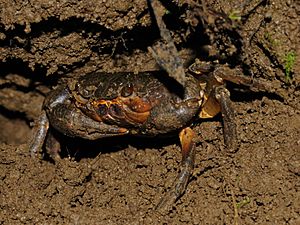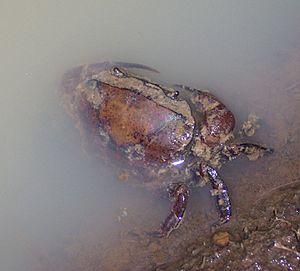Freshwater crab facts for kids

Freshwater crabs are crabs that live in fresh water, mostly in the tropics and subtropics. About 1300 species of freshwater crab have been described. In total, there are about 6700 species of crab. It is thought that there are many undescribed species of freshwater crab; there may be up to 2155 such species. Freshwater crabs show different behaviour than other crabs. Other crabs release a large number of larvae into the environment. These larvae need to cope on their own. In contrast, freshwater crabs care for the young. Many freshwater crabs are endemic to small areas. This means there if there is a threat of the area of dissapearing, this also applies to the crab, which becomes threatened with extinction.
Description and life cycle

Development of freshwater crabs is characteristically direct, where the eggs hatch as juveniles, with the larval stages passing within the egg. The broods comprise only a few hundred eggs (compared to hundreds of thousands for marine crabs) each of which is quite large, at a diameter of around 1 mm (0.04 in).
The colonisation of fresh water has required crabs to alter their water balance; freshwater crabs can reabsorb salt from their urine, and have various adaptations to reduce the loss of water. In addition to their gills, freshwater crabs have a "pseudo-lung" in their gill chamber that allows them to breathe in air. These developments have pre-adapted freshwater crabs for terrestrial living, although freshwater crabs need to return to water periodically in order to excrete ammonia.
Ecology and conservation
Freshwater crabs are found throughout the tropical and sub-tropical regions of the world. They live in a wide range of water bodies, from fast-flowing rivers to swamps, as well as in tree boles or caves. They are primarily nocturnal, emerging to feed at night; most are omnivores, although a small number are specialist predators, such as Platythelphusa armata from Lake Tanganyika, which feeds almost entirely on snails. Some species provide important food sources for various vertebrates. A number of freshwater crabs are secondary hosts of flukes in the genus Paragonimus, which causes paragonimiasis in humans.
In West Africa, species that live in savannahs have wider ranges than species from the rainforest; in East Africa, species from the mountains have restricted distributions, while lowland species are more widespread.
For which data are available, 32% are threatened with extinction. For instance, all but one of Sri Lanka's 50 freshwater crab species are only found in that country, and more than half are critically endangered.
See also
 In Spanish: Cangrejo de agua dulce para niños
In Spanish: Cangrejo de agua dulce para niños


